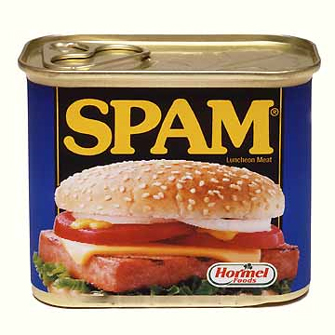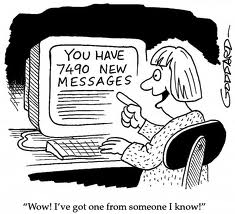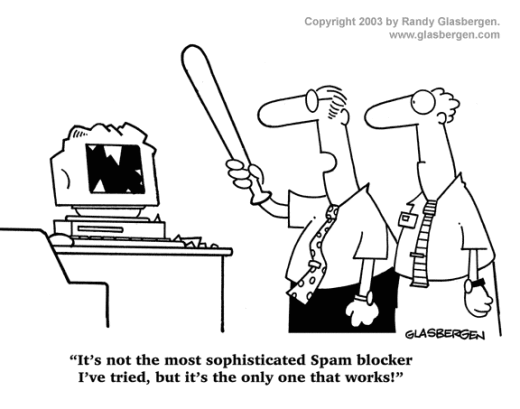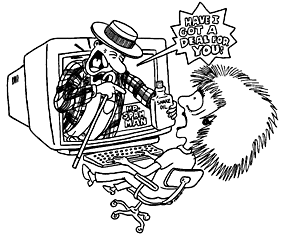My name is Spam.
Spam I Am.
I have some stuff I'd like to sell.
Take a look! It's really swell!
I do not want your worthless spam.
I do not want it, Spam I Am.
Spam I Am:
$500 software that really rocks!
Just 20 bucks--still in the box!
You are really full of bunk.
I do not want your bootleg junk!
I do not want your worthless Spam.
I do not want it Spam I Am.
Spam I Am:
How about some fast cash?
Fifty Thousand in a flash!!!
How stupid do you think I am?
I won't join your shady scam.
You are a sucker, you silly gitch.
If it worked, we'd all be rich!
I do not want your worthless spam.
I do not want it Spam I Am.
Spam I Am:
Check out this great idea of mine!
For Web Hosting and Design!
I went to your site; it really sucks!
For this you're charging lots of bucks?
You could at least learn to spell.
Why don't you just go to hell.
I do not want your worthless spam.
I do not want it Spam I Am.
Don't pretend your ads are new.
You insult us when you do.
I won't buy your worthless stocks.
Our heads are not full of rocks
Stop it Spam. Enough's enough.
I do not want your trashy stuff!
I do not want your damn spam!
I do not want it Spam I Am!
Experts
target junk e-mail
By Susannah Price, BBC, Washington
 A three-day meeting in Washington on junk electronic mail has closed
with a call for immediate action to be taken. The conference, organised
by the Federal Trade Commission, was looking at the proliferation of commercial
e-mail and exploring the technical, legal and financial issues that
spam raises.
A three-day meeting in Washington on junk electronic mail has closed
with a call for immediate action to be taken. The conference, organised
by the Federal Trade Commission, was looking at the proliferation of commercial
e-mail and exploring the technical, legal and financial issues that
spam raises.
Speakers at the conference painted a gloomy future for e-mail unless
the problem of spam is immediately addressed. A Federal Trade Commission
representative said things were worse than they had imagined and without
immediate improvements, e-mail could be run into the ground. Internet providers
said it was the sheer number of messages that posed the threat.
Strategies
There were different views on the best way to tackle the problem
of spam, which now accounts for more than 40% of e-mails. Many at the forum
suggested new countrywide legislation was needed in the United States,
but others said the only solution was to block spam with new technology.
The forum brought together internet providers, anti-spam campaigners
and Washington policy makers, but it also heard from e-mail marketers,
who maintained that reputable operators only sent messages to consumers
who wanted to hear from them.
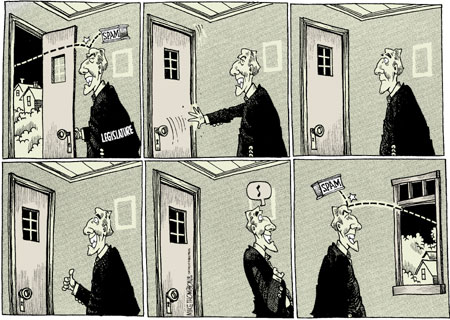
Where
spam comes from
 For anyone plagued by junk e-mails, the question that often baffles
most is how did the spammers get your address. US researchers at
the Center for Democracy and Technology set out to answer this question
in the summer of 2002. They found that e-mail addresses posted on websites
or in newsgroups attract the most spam. Spam is estimated to
account for up to 40% of global e-mail traffic and is causing a massive
headache for businesses, which are losing billions in productivity.
For anyone plagued by junk e-mails, the question that often baffles
most is how did the spammers get your address. US researchers at
the Center for Democracy and Technology set out to answer this question
in the summer of 2002. They found that e-mail addresses posted on websites
or in newsgroups attract the most spam. Spam is estimated to
account for up to 40% of global e-mail traffic and is causing a massive
headache for businesses, which are losing billions in productivity.
E-mails on the web
To determine the source of spam, the researchers set up hundreds
of different e-mail addresses and waited six months to see what kind of
mail the addresses were attracting. For the purposes of the study, researchers
posted e-mail addresses on websites and newsgroups. They also provided
e-mail addresses in response to services on popular websites such as auction
site eBay and e-commerce favourite Amazon. E-mail addresses were also sent
to websites in response to jobs, auctions and discussion boards. Finally
researchers posted addresses in the Whois database of information about
the owners of domain names.
Evasive techniques
The researchers found that spammers used harvesting programs such
as robots and spiders to record e-mail addresses listed on both personal
and corporate websites. One way of avoiding this mail-harvesting,
said the team, is to replace characters in an e-mail address with human-readable
equivalents - for example john@domain.com would become john at domain dot
com.
Another successful evasion technique is to replace the characters
in an e-mail address with the HTML equivalent. None of the project's addresses
written in human-readable formats or HTML received a single piece of spam.
Over the course of the six-month study, the researchers received over 10,000
e-mail messages to the 250 e-mail addresses they had created. Only about
1,600 of these were legitimate e-mails. Over 97% of the spam was sent to
addresses that had been posted on public websites. The number of messages
received was linked to the popularity of the website. Organisations linked
to major portals such as AOL and Yahoo received a lot more spam than
those without links. AOL is currently waging its own war on spammers, recently
launching over a dozen lawsuits against individuals and companies it claims
is sending unsolicited mail to its members.
Opting out
The research also looked at whether websites respected consumer
attempts to opt out of receiving commercial e-mail. In all cases where
researchers asked not to receive commercial e-mails, their wishes were
respected. Opting out of e-mail communications further down the line also
resulted in the majority of websites complying with the request. The study
found that most web companies did not share or sell e-mail addresses to
third parties. Just 25 spam messages were received as a result of inappropriate
sharing or selling of e-mail addresses, and most of these were from gambling
and adult-content related websites.
Scatter gun approach
At one point during the study, the system began receiving spam messages
to addresses that had never been used for any purpose or submitted to anyone.
Such brute force attacks, in which spammers attempt to send e-mails to
every possible combination of letters that could form an e-mail address,
are relatively common. The system received over 8,000 brute force e-mails
before a block was installed. These messages were not included in the final
data.
Mid-week
suffers spam overload
Ref: BBC News
Next Thursday keep an eye on the size of your inbox as this is the
most popular day for spamming.
A survey by the counter-spam firm Brightmail detected more than
four million pieces of junk mail on just this day sent to UK internet users.
The volume of unsolicited mail has shot up in the last year, making
up nearly half of all net traffic, according to some estimates. An insight
into the staggering scale of the spam problem was provided by Microsoft,
which said this week that it now blocks 2.4 billion junk messages to its
MSN and Hotmail subscribers every day.
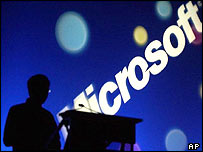
'Astonishing' figure
Brightmail monitored mails sent for a week in March over the UK net
provider, BT Openworld. It found that nearly 11 million out of 25 million
messages were scanned were spam - a weekly average of 41%. The deluge of
spam is prompting online services like BT Openworld to take action to stem
the flow of unwanted offers for miracle cures, get-rich-quick schemes and
adult products.
Legal steps
In the US, internet giants AOL, Yahoo and Microsoft have all been touting
their anti-spam features. AOL recently said it blocked about two billion
junk messages in a single day, while last week Microsoft revealed its anti-spam
measures now net about 2.4 billion spam e-mails sent to its Hotmail and
MSN customers. Law suits brought by Microsoft and AOL against suspected
spammers are still making their way through the courts. The US and other
governments are also preparing various cases against individual spammers,
and legislators in various countries are mulling rules to make such e-mails
illegal or harder to send.
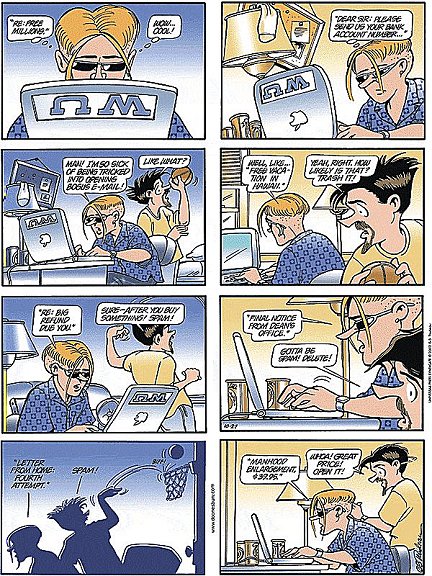
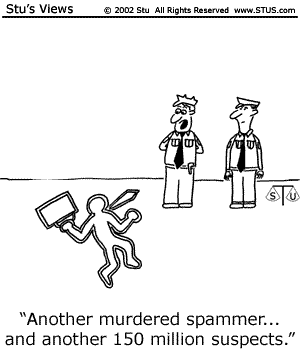


Junk
e-mail 'stresses workers'
BBC News
Junk e-mails are one of the main causes of stress for office workers
but few know what to do about it, says internet company Yahoo. A poll of
1,000 computer users found that one in four had been fooled into opening
unwanted messages believing them to be genuine.
On Thursday Yahoo launched a campaign to make people wary about what
they open as part of a worldwide Dump The Junk Day, aimed at advising people
never to reply to junk e-mails or forward them to friends. John Webb,
head of Yahoo Mail in the UK, said: "Our research shows that many British
internet surfers don't have the knowledge to tackle junk mail effectively
with over half of Britons actually helping to perpetuate the junk mail
cycle."
Spam programmes
An estimated 40% of e-mails sent worldwide are junk, costing firms huge
amounts of money in delays and lost production.
SPAM SURVEY
94% of
Britons find junk mail hugely annoying
56% unwittingly
reply to spam
More than
25% had been fooled into opening spam
Only 2%
have made a purchase in response to junk mail
Source: Yahoo survey
Yahoo found that spam has become one of the most irritating aspects
of working life in the UK. Junk e-mails ranked behind traffic jams and
long working hours as causing stress for office workers. But Yahoo found
that many people are unknowingly making things worse by replying to the
messages. "Junk mail is effectively an intrusion of our privacy and one
which many people lack the knowledge to protect themselves against," said
Big Brother psychologist Professor Geoffrey Beattie. "Whether the junk
mail is coming into a personal or work e-mail inbox, unsurprisingly it
leads to feelings of lacking control, frustration and anger."
Fighting spam
The big internet service providers (ISP) all offer "anti-spam" programmes
to weed out the unwanted mail. Last week Microsoft said that it now
blocked 2.4 billion junk messages to its MSN and Hotmail subscribers every
day. And AOL - the world's largest ISP - is suing more than 12 individuals
and companies who are allegedly responsible for sending one billion unsolicited
messages. The company recently said it blocked about two billion
junk messages in a single day, while last week Microsoft revealed its anti-spam
measures now net about 2.4 billion spam e-mails sent to its Hotmail and
MSN customers.
Arthur C Clarke sees e-mail
for all
There are few people
alive who can claim to have contributed more to the world of science than
Sir Arthur C Clarke. He has just celebrated his 85th birthday. In a rare
interview with the BBC, he shared his vision of a future when everyone
would be hooked up to the internet. Human society and civilisation
is essentially based on technology. Without it we would be back in the
jungle. Technology began with fire, with tools and has gone all the way
to now. Without it we would be nothing and of course there are good aspects
and bad aspects. Everyone knows what they are.
The various forms of entertainment that have come in over the last century
have made life richer and on the whole more enjoyable. The other
thing that has revolutionised my life and the life of many others, except
perhaps a few yak herders in Outer Mongolia is e-mail.
Digital worlds
I cannot imagine life before e-mail. Our ancestors live in a tiny limited
world, knowing nothing about what was going on beyond the horizon. We do
live in an infinitely richer world and are definitely better for it. But
it is true that we are getting two different worlds now. Some people have
access to information and I am sure a few yak herders in Mongolia do have
access to e-mail. But the bulk of the world does not.
This is something that will be slowly rectified, just as after all there
was a time when there were hardly any newspapers. When printing was invented,
somebody said this is very interesting but what good is it when nobody
can read?
 Arthur C Clarke was talking to Francis Harrison for the
BBC World programme,
Arthur C Clarke was talking to Francis Harrison for the
BBC World programme,
Story from BBC NEWS:
http://news.bbc.co.uk/go/pr/fr/-/1/hi/technology/2949974.stm
Children
upset by spam e-mail
BBC NEWS:
Four out of five children receive inappropriate spam e-mails touting
online drugs, get-rich-quick schemes and porn, a survey has suggested.
Internet security firm Symantec found that most children felt uncomfortable
and offended by the junk messages. For the study, Symantec asked
1,000 US youngsters between the ages of seven and 18 about their experiences
with spam. More than 80% of those interviewed received inappropriate spam
on a daily basis, with half saying it made them feel uncomfortable and
offended.
Dangers of spam
Children, like adults, are bombarded by spam advertising Viagra, pornographic
material and other inappropriate products and services.
WHAT CHILDREN ARE READING
80% received sweepstake messages
62% receive information on dating services
47% receive links to pornographic sites
One in five children opened and read spam, and more than half of them
checked their e-mail without parental knowledge. Nearly half had received
links to pornographic websites. "As with any e-mail user, kids are just
as susceptible as adults to being bombarded by spam," said Steve Cullen,
Senior Vice President of Symantec. "Parents need to educate their children
about the dangers of spam and how they can avoid being exposed to offensive
content or becoming innocent victims of online fraud," he added.
Good or bad?
Most of those interviewed had personal e-mail accounts but many seemed
to be confused about the dangers of spam.
TIPS FOR PARENTS
Talk to children about inappropriate web content
Teach children not to give out personal information while surfing
Trust your children and do not be overprotective
Know your children's friends
Check e-mails with your children
Some 38% did not tell their parents that they had been upset by spam
and 22% said that their parents had not talked to them about spam. Nearly
one in three did not know whether spam was good or bad for them.
Spam now accounts for half of all e-mails sent and has become a massive
nuisance for both home and business surfers.
Governments are beginning to recognise the menace of junk e-mail. In
the autumn the European Union will make unsolicited messages illegal across
all member states.
REAL MAIL: Holiday
Card Etiquette
For business/work relationships
• Business greeting cards should be more formal than cards for family
and social friends.
• Mail cards for business associates to their office, unless you are
social friends or have met the person’s spouse.
• When sending to a co-worker in your own office, send the card to
the home and address it to “Mr. and Mrs.” if the recipient is married.
• When sending to a married woman who uses her maiden name at work,
address the cards to “Mr. and Mrs. John Smith.” If she prefers to use her
maiden name for all occasions, work and social, address the card to “Mr.
John Smith and Ms. Susan Jones.”
• Sign only your name to a card for a business associate, unless your
spouse has met the recipient.
For family and friends
• Personalize your cards with a little note, and always sign the card
– even if your name is printed.
• Keep your signature informal – no last names. Traditionally, family
signatures begin with the father’s name, then the mother’s and finally
the children, or simply "John, Mary and family."
• When a card is from more than one person, the person who signs it
should write his or her name last as a gesture of courtesy.
• When sending a card to a couple with two different last names, address
the card to “Mary Smith and John Jones.” If there are children, write “Mary
Smith, John Jones and Family.”
• When addressing cards to family and social friends, include the children’s
names.
Proper placement of a card in the envelope
• Insert the folded side into the envelope first with the design face
up toward the flap.





